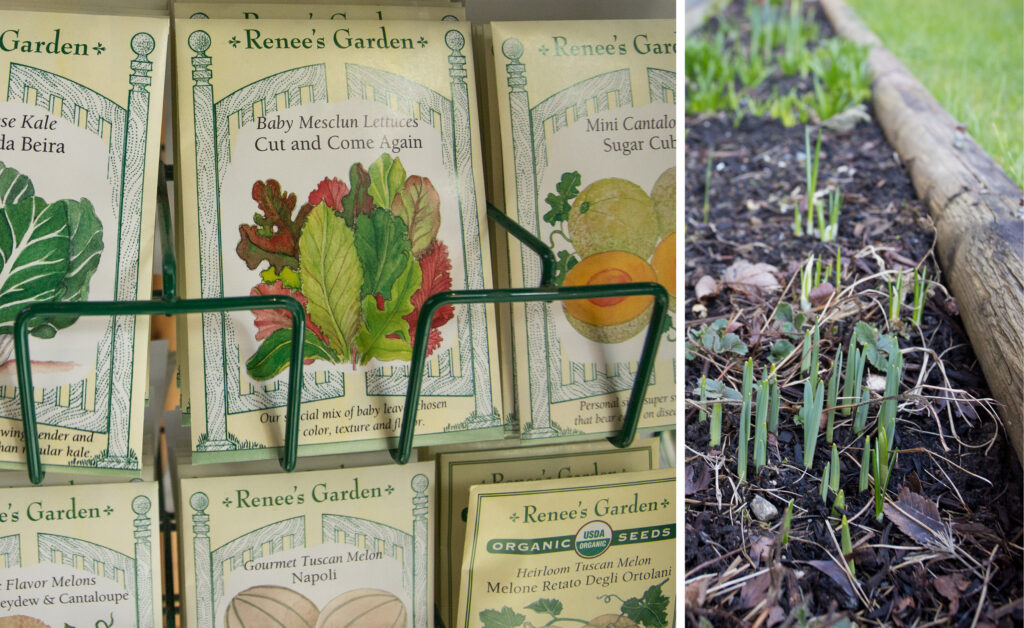story and photos by Kathryn Alvarez –
Spring is upon us, and now is a good time to plan your summer vegetable garden. If you’ve never had a vegetable garden before but are interested in growing food for you and/or your family and don’t know where to start, read on.
Pick the Right Location
Do you have a space in your yard that can be converted into a vegetable bed, or an existing bed you could use for vegetables? Or do you have a patio or balcony on which you could grow food in containers?
How much sun do you get from March to September in your proposed spot? Many vegetables such as tomatoes, peppers and other heat-lovers need about six to eight hours of sun each day. Lettuce and other leaf vegetables can grow in shadier gardens as long as they have about four hours of sun during the summer (although they will grow more slowly).
Soil should be nutrient-rich, well-draining and be free from rocks and roots. If you’re not able to remove the rocks by yourself, if the garden bed has encroaching roots from nearby trees or hedges, or if the soil drains poorly so that water pools, plant veggies in a raised garden bed.
Keep deer and rabbits in mind when choosing the best site for your vegetable garden as they can – and will – eat your veggies (especially tender, sweet seedlings). You may want to consider installing mesh netting around your vegetable garden so you can access the garden but critters can’t.
Design Your Vegetable Garden
Garden beds in the ground can be any length or shape but should be narrow enough so that you can reach the centre of the bed without stepping onto the soil; compacted soil is not optimal for growing seeds and seedlings.
If you choose a free-standing raised garden bed, think of the type of material you have to build the frame – rocks, bricks or wood (if wood, stay away from painted or pressure-treated wood that may leach chemicals or lead into your soil). For raised beds, you’ll need to add at least 12 to 18 inches of good quality soil. Alternatively, you could build a raised bed without a frame: mound the soil six to eight inches high, and flatten the top.
When selecting pots for your container veggie garden, choose containers that provide at least 12 inches of soil (or more, for larger plants) so that the roots have room to grow and ensure there is a hole in the bottom of the container for drainage.
Keep irrigation in mind. Will you be hand watering or delivering water through drip irrigation? Vegetable gardens need a lot of water, especially in the hot and dry summer months.
Choose What to Plant
Ultimately, grow vegetables that you like to eat. You can either grow veggies from seed (which is economical) or buy veggie starts/seedlings and transplant them into your garden bed (which is easier). For beginner gardeners, there are vegetables that are easier to grow than others in our region: lettuce and other salad greens, garlic, broccoli, cabbage, kale, zucchini, beans, peas, radishes, beets, turnips, potatoes, Swiss chard and herbs. Plants with small root systems and those that produce over a long growing season are ideal for container gardens. These include tomatoes, peppers, eggplants, cucumbers, bush varieties of squash, pole beans, herbs, strawberries, and various salad greens.
Develop Your Garden Plan
Make a list of what you want to grow and the dates you need to sow seeds or transplant starts, and when to harvest. Sketch a plan of your veggie bed and pencil in where each crop could go. Keep a record so you can improve on your planting plan for the next year; note varieties of vegetables, garden plans, planting dates, harvest dates and any pest problems.
Happy planning!




